ServiceNow: Implementing KCS Delivered 52% Faster Time to Relief
Moving from a transaction mindset to resolve customer issues faster
As a cloud company, ServiceNow strives to provide excellent technical support to its customers, whether it’s a password reset or release upgrade. Sharing knowledge among Technical Support Engineers (TSEs, or customer service agents), customers, and partners is critical to ServiceNow's success.
As the company grew, creating and curating knowledge became a major challenge. In the past, knowledge was captured by individual TSEs in email, intranet sites, notes, documents, and often just in their heads. Little formal knowledge sharing was occurring within or between teams, even in the same region. In addition, each region supported its own customers, creating silos. TSEs were solving the same issues over and over; more than 60% had been already solved but the resolutions were not captured in a findable, reusable way .
ServiceNow recognized that as their case volume increased they needed better ways for customers and partners to find answers quickly. They decided on a fresh start to improve efficiency. By adopting a formal program, ServiceNow could scale to accommodate their fast growth.
Business requirements included:
- Developing a single, cross-collaborative centralized knowledge base shared across the globe
- Increasing the findability and consumption of relevant knowledge so that customers, partners, and TSEs could find answers and resolve issues faster
- Empowering TSEs to create content at the time a solution is proposed instead of later so knowledge is not lost
- Employing a content curation approach where all TSEs were responsible to flag out of date content and experts could update articles real-time
- Helping new hires get up to speed faster on ServiceNow products using the Knowledge Base (KB)

Used with permission from ServiceNow, Inc.
The ServiceNow team looked at people, process, and technology. Organizational change came first. They created a global support organization, where support delivery followed the sun and was not regional or customer-specific. They embraced ServiceNow Knowledge Management as the platform to manage knowledge sharing on a global scale (ServiceNow Customer Service Management is KCS v6 Verified). In 2018, ServiceNow began transitioning to Knowledge-Centered Service (KCS), an industry best practice to capture knowledge and drive efficiency.
KCS is integral to the ServiceNow self-service strategy that enables customers to self-solve issues faster, and, when they need it, get assistance from a ServiceNow TSE. When combined with ServiceNow Knowledge Management, KCS enabled ServiceNow to move the entire Technical Support organization from a transactional mindset to one focused on resolving issues as quickly as possible.
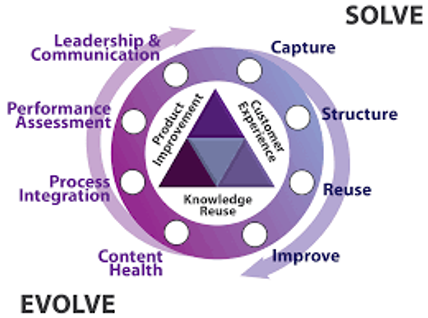 Over 15 months, the entire global Technical Support organization was trained on the new KCS methodology. KCS involves two main concepts:
Over 15 months, the entire global Technical Support organization was trained on the new KCS methodology. KCS involves two main concepts:
- The Solve Loop that defines how to capture, structure, reuse, or flag/fix knowledge
- The Evolve Loop that defines curation and retirement. This identifies which articles to invest in, which to update, and which to archive.
Adopting a KCS mindset
In the past, a small subset of the global team wrote Knowledge Base (KB) articles. A multi-step approval process delayed content availability by weeks, and curation to remove outdated or duplicate content was an issue. Information was used only by those who created it, which wasn’t efficient or scalable.
To address these issues, ServiceNow adopted a KCS process that works like this:
- Customers search for answers to questions or issues on the ServiceNow Service Portal. Relevant articles are displayed via search.
- If customers don’t find an answer, they submit a case. At the time the case is opened, more KB articles are displayed to customers.
- When a TSE is assigned the case, machine learning is used to locate KB articles that may contain relevant content.
- If no KB articles address the issue, TSEs are empowered to update existing content or create new content.
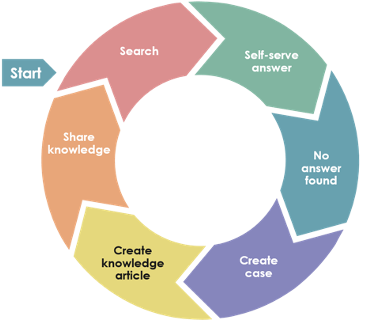 Once the solution is accepted by the customer, a process starts where the relevant information from a case is copied into a draft article
Once the solution is accepted by the customer, a process starts where the relevant information from a case is copied into a draft article- TSEs are empowered to publish the article in the KB and defines who can see it. The article is automatically posted in the KB and is searchable in the Service Portal, ServiceNow Community, and from search engines such as Google and Bing (if the content has been made public).
Used with permission from ServiceNow, Inc.

Used with permission from ServiceNow, Inc.
Through tight integration between Customer Service Management (CSM), knowledge, and portal, new content from the KB is brought into customer search, customer case submission, and TSE case assignment. Since the program started, ServiceNow has seen:
- An 87% increase in attach rate of KB articles to cases by TSEs
- Over 10,000 new KB articles created in the past year
- Cases with attached KB articles are solved 52% faster
Training Global Technical Support
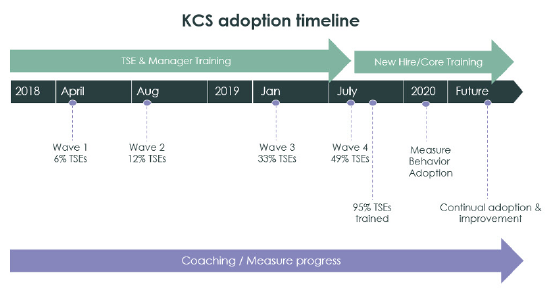 Used with permission from ServiceNow, Inc.
Used with permission from ServiceNow, Inc.
ServiceNow Global Technical Support operations consists of more than 500 TSEs. KCS training was rolled out in multiple waves, from April 2018 through July 2019. The size of each training group doubled as the process was refined and the training and coaching team could scale.
The investment in KCS required a change to ServiceNow's cultural mindset. This change started at the grassroots level with a small group of KCS champions who participated in the Wave 1 rollout. This group consisted of people known as early adopters who welcomed change. They designed the new process and suggested improvements to the Knowledge Management configuration for page layouts, workflow, and approval processes.
KCS coaches conducted training with the Wave 1 TSEs, who were selected because of their enthusiasm and understanding of the benefits of KCS. After initial training, every TSE was required to create one article within two days of the course so trainers could assess how much had been learned.
Used with permission from ServiceNow, Inc.
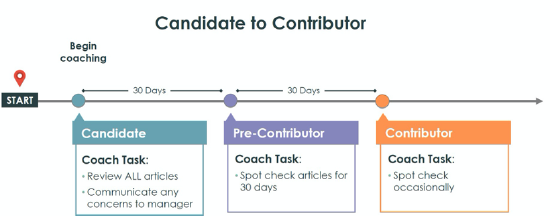 KCS coaches play a major role in the overall process adoption. Using the Article Quality Index (AQI) feature, coaches assess the quality of the KB content created by the KCS candidates. They monitor candidates’ progress, including assessing their ability to create quality articles against a content standard and follow the KCS workflow. Each coach is assigned up to five TSEs from their team. The coaching period lasts two to three months as the candidates become contributors. After they reach the Contributor status, they can publish immediately, without additional approvals.
KCS coaches play a major role in the overall process adoption. Using the Article Quality Index (AQI) feature, coaches assess the quality of the KB content created by the KCS candidates. They monitor candidates’ progress, including assessing their ability to create quality articles against a content standard and follow the KCS workflow. Each coach is assigned up to five TSEs from their team. The coaching period lasts two to three months as the candidates become contributors. After they reach the Contributor status, they can publish immediately, without additional approvals.
ServiceNow believes that if they trust TSEs to communicate with their customers during the problem-solving process without any peer review, they should also trust them to create good content consumable by everyone. To help with this shift, ServiceNow began measuring article attach quality, a metric that gives managers and coaches actionable data to coach TSEs in content writing. This metric makes it easy to find contributors who may need more training.
Using the Article Ownership Group feature, ServiceNow also built an AI model to assess the reputation of an article. Captured metrics include how many times an article was attached, viewed, created a deflection, was last updated, etc. This information is used to retire any articles that are not adding value to the knowledge ecosystem.
Next steps include adding videos in the KB for areas with a high volume of cases. The ServiceNow team continually monitors search engine optimization (SEO) to find unauthenticated content and verify that it is relevant and searchable. Over time, they are also finding more opportunities to use AI and machine learning to automate knowledge capture, sharing, and curating.
Measuring success during the journey
ServiceNow closely tracks their performance to see progress and address issues immediately. They identified key metrics around three areas: global adoption, regional progress, and program performance. The metrics ensure the team continues to deliver excellent customer support while striving for continual improvement.
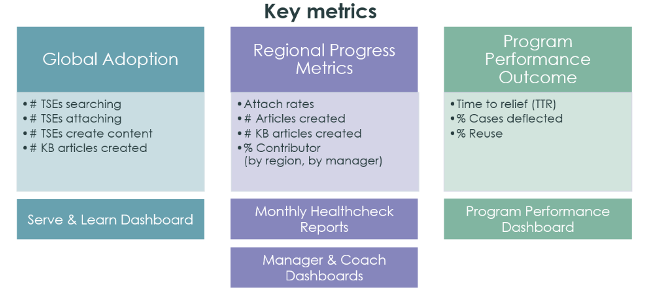
Used with permission from ServiceNow, Inc.
ServiceNow measures their progress using these reports:
Monthly Healthcheck Report
Generated for each region, these reports feature key metrics in a heatmap format. Global Technical Support leadership can quickly see the progress and status of the KCS program in several key areas and decide what areas need improvement.

Used with permission from ServiceNow, Inc.
Attach Quality Dashboard
This dashboard helps ServiceNow monitor TSE process adoption. It highlights when a TSE attaches an article after a case is closed or creates a new article more than 10 days after the case is closed. It also checks that a TSE is not attaching administrative articles or landing pages as a way to game an individual attach rate. This report can be filtered by subject matter expert groups, geographic region, location, and manager.
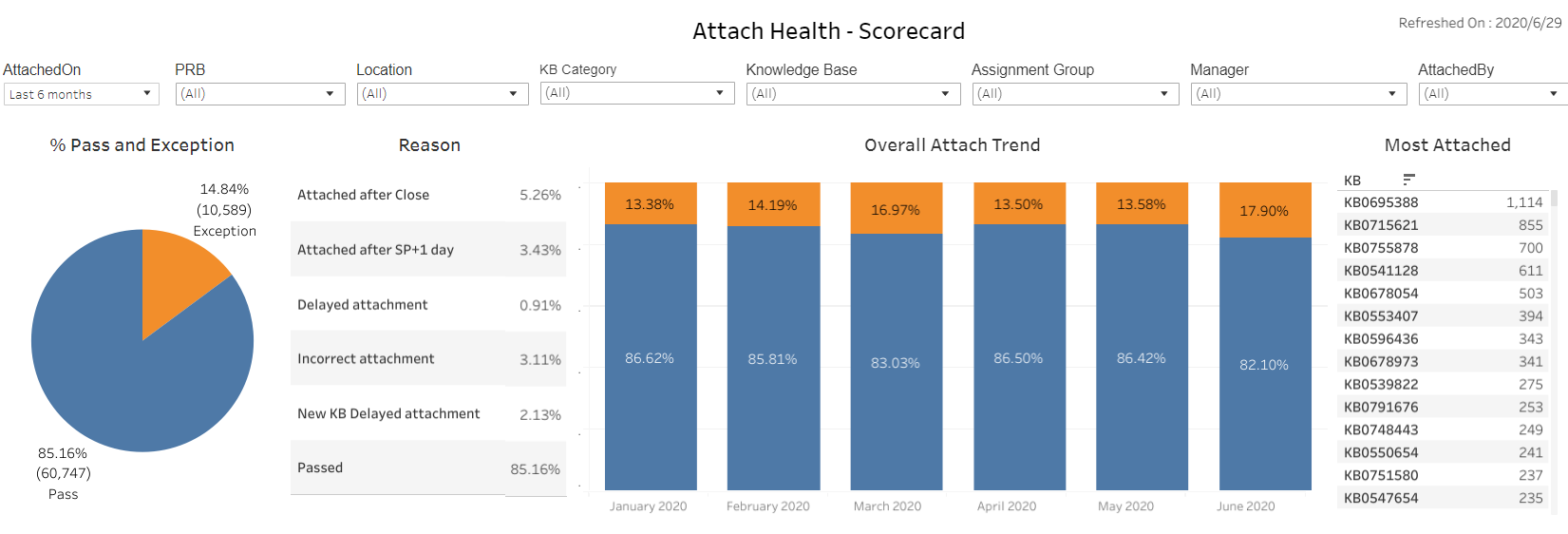
Used with permission from ServiceNow, Inc.
Content Evolution Dashboard
This dashboard calculates a KB Score based on engagement: that is, the number of internal users attaching and viewing the article and how many customers engaging in it. This score helps ServiceNow flag the least used articles for review and curation. Reports can be generated by subject matter expert groups, geographic region, location, and manager.
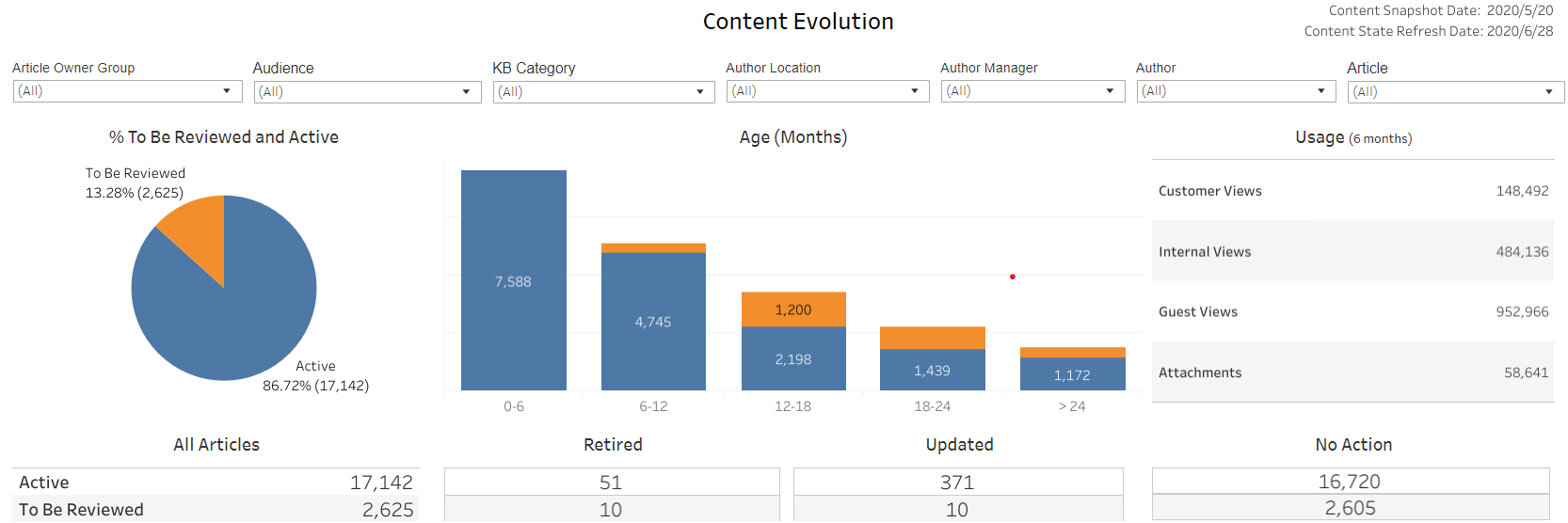
Used with permission from ServiceNow, Inc.
What ServiceNow learned along the way
Looking back, ServiceNow has identified three lessons that it applies in ongoing assessments of its progress:
- Monitor KCS behaviors. ServiceNow does this by measuring how much content is being attached to cases, including new and existing content. Then they look at the quality: How many views did the article get? That tells them if it helped anyone.
- Measure progress from candidate to contributor. How long does it take for a TSE to contribute relevant content? ServiceNow is always looking at ways to shorten this learning cycle through training and feedback, especially for new hires.
- Include everyone in the content generation process. Small groups slow down knowledge sharing. By making sure knowledge is captured and shared quickly, customers, TSEs, and even new hires can obtain relief much faster than in the past.
Embracing early product releases
Technical Support works closely with the Knowledge Management product development team to integrate KCS process requirements into the ServiceNow Customer Service Management application. They have imprinted their product experience into the product development lifecycle, including recommending useful enhancements, such as a single button to convert new content to a KB article. They have implemented new features such as the AI similarity feature that uses machine learning to help TSEs find similar KB articles and case and problems records with one click.
KCS drives faster issue resolution
The overall result is that the volume of cases being submitted by customers is dropping because knowledge is easily findable and consumable, even as the ServiceNow customer base grows. Automation of the knowledge sharing process has been critical to this success. Job satisfaction is improving as TSEs are solving more complex issues and eliminating common and repeat issues. The contributor certification speeds up new process adoption. With Customer Service Management running on the Now Platform®, knowledge can be instantly and automatically shared across regions and geographies and accessed via the Service Portal, Service Catalog, Product Documentation, Knowledge Base, Virtual Agent, and Community.
About ServiceNow
ServiceNow is making the world of work, work better for people. Its cloud-based platform and solutions deliver digital workflows that create great experiences and unlock productivity for employees and the enterprise. For more information, visit: www.servicenow.com.
Now on Now is about how ServiceNow uses their own ServiceNow solutions to work faster, smarter, and achieve true end-to-end digital transformation. To learn more about how ServiceNow uses Knowledge Management and KCS, visit the Now on Now website.
About the Consortium for Service Innovation
The Consortium for Service Innovation is a non-profit alliance of organizations focused on innovation for the support industry. The Consortium and its members have developed the KCS methodology over the last 25 years, and are committed to developing innovative ways to deliver customer support.
© 2020 Consortium for Service Innovation. Written by ServiceNow for the Consortium for Service Innovation. All Rights Reserved.
Consortium for Service Innovation™ and the Consortium for Service Innovation logo are trademarks of Consortium for Service Innovation. Intelligent Swarming℠ and KCS® are registered service marks of the Consortium for Service Innovation.
ServiceNow, the ServiceNow logo, Now, and other ServiceNow marks are trademarks and/or registered trademarks of ServiceNow, Inc., in the United States and/or other countries.
